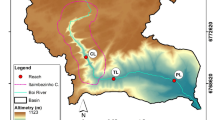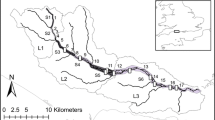Abstract
The Gunnison River in the Black Canyon of the Gunnison National Park (BCNP) near Montrose, Colorado is a mixed gravel and bedrock river with ephemeral side tributaries. Flow rates are controlled immediately upstream by a diversion tunnel and three reservoirs. The management of the hydraulic control structures has decreased low-frequency, high-stage flows, which are the dominant geomorphic force in bedrock channel systems. We developed a simple model to estimate the extent of sediment mobilization at a given flow in the BCNP and to evaluate changes in the extent and frequency of sediment mobilization for flow regimes before and after flow regulation in 1966. Our methodology provides a screening process for identifying and prioritizing areas in terms of sediment mobility criteria when more precise systematic field data are unavailable. The model uses the ratio between reach-averaged bed shear stress and critical shear stress to estimate when a particular grain size is mobilized for a given reach. We used aerial photography from 1992, digital elevation models, and field surveys to identify individual reaches and estimate reach-averaged hydraulic geometry. Pebble counts of talus and debris fan deposits were used to estimate regional colluvial grain-size distributions. Our results show that the frequency of flows mobilizing river bank sediment along a majority of the Gunnison River in the BCNP has significantly declined since 1966. The model results correspond well to those obtained from more detailed, site-specific field studies carried out by other investigators. Decreases in the frequency of significant sediment-mobilizing flows were more pronounced for regions within the BCNP where the channel gradient is lower. Implications of these results for management include increased risk of encroachment of vegetation on the active channel and long-term channel narrowing by colluvial deposits. It must be recognized that our methodology represents a screening of regional differences in sediment mobility. More precise estimates of hydraulic and sediment parameters would likely be required for dictating quantitative management objectives within the context of sediment mobility and sensitivity to changes in the flow regime.










Similar content being viewed by others
References
Auble GT, Friedman J, Scott ML (1991) Riparian vegetation of the Black Canyon of the Gunnison River, Colorado: Composition and response to selected hydrologic regimes based on a direct gradient assessment model. Unpublished report to the National Park Service
Baker VR (1988) Flood erosion. In: Baker VR, Kochel RC, Patton PC (eds) Flood geomorphology. Wiley, New York, pp 81–95
Baker VR, Kale VS (1998) The role of extreme floods in shaping bedrock channels. In: Tinkler KJ, Wohl EE, (eds) Rivers over rock: Fluvial processes in bedrock channels. American Geophysical Union Press, Washington, DC, pp 105–131
Buffington JM, Montgomery DR (1997) A systematic analysis of eight decades of incipient motion studies, with special reference to gravel-bedded rivers. Water Resources Res 33:1993–2029
Cenderelli DA, Wohl EE (2003) Flow hydraulics and geomorphic effects of glacial-lake outburst floods in the Mount Everest region, Nepal. Earth Surf Processes Landforms 28:385–407
Chase KJ (1992) Gunnison River thresholds for gravel and cobble motion, Black Canyon of the Gunnison National Monument. MS thesis, Colorado State University, Ft. Collins
Diaz GE, Salas JD, Farris GE (1996) Impact of diversions and river regulation on the flows of the Gunnison River at the Black Canyon, Colorado. Technical Report No. 3. Computing Hydrology Laboratory, Hydrologic Science and Engineering Program, Engineering Research Center, Colorado State University, Fort Collins
Elliott JG, Hammack LA (2000a) Entrainment of riparian gravel and cobbles in an alluvial reach of a regulated canyon river. Regul Rivers 16:37–50
Elliott JG, Hammack LA (2000b) Geomorphic and sedimentologic characteristics of alluvial reaches in the Black Canyon of the Gunnison National Monument, Colorado. US Geological Survey Water Resources Investigations Report 99-4082, US Geological Survey, Denver, Colorado
Elliott JG, Parker RS (1997) Altered streamflow and sediment entrainment in the Gunnison Gorge. Water Resources Bull 33:1041–1054
Friedman JM, Auble GT (1999) Mortality of riparian box elder from sediment mobilization and extended inundation. Regul Rivers 15:463–476
Grams PE, Schmidt JC (2002) Streamflow regulation and multi-level flood plain formation: channel narrowing on the aggrading Green River in the eastern Uinta Mountains, Colorado and Utah. Geomorphology 44:337–360
Hansen W (1971) Geologic map of the Black Canyon of the Gunnison River and Vicinity, Western Colorado. USGS Miscellaneous Geologic Investigations: Map I-584. US Geological Survey, Denver, Colorado
Komar PD (1987) Selective gravel entrainment and the empirical evaluation of flow competence. Sedimentology 34:1165–1176
Konrad, Booth DB, Burges, Montgomery DR (2002) Partial entrainment of gravel bars during floods. Water Resources Res 38:10.1029/2001WR000828
Larsen IJ, Schmidt JC, Martin JA (2004) Debris-fan reworking during low-magnitude floods in the Green River canyons of the eastern Uinta Mountains, Colorado and Utah. Geology 32:309–312
Liquori MK (1995) Coarse clast delivery and transport processes in the Black Canyon of the Gunnison River, Colorado. MS thesis, Colorado State University, Ft. Collins
National Park Service (2004) Curecanti National Recreation Area website: http://www.nps.gov/cure/index.htm
Pizzuto JE, Webb RH, Griffiths PG, Elliott JG, Melis TS (1999) Entrainment of cobbles and boulders from debris fans. In: Webb RH, et al. (eds) The controlled flood in Grand Canyon, American Geophysical Union Press, Washington, DC, pp 53–70
Powell DM (1998) Patterns and processes of sediment sorting in gravel-bed rivers. Prog Phys Geogr 22:1–32
Tinkler KJ, Wohl EE (1998) A primer on bedrock channels. In: Tinkler KJ, Wohl EE (eds) Rivers over rock: fluvial processes in bedrock channels. American Geophysical Union Press, Washington, DC, pp 1–18
Troendle CA (1992) Sediment transport for instream flow and channel maintenance. In: Proceedings of the Technical Workshop on Sediments, EPA and Forest Service, Corvallis, OR, pp 1–4
Webb RH, Melis TS, Griffiths PG, Elliott JG (1999) Reworking of aggraded debris fans. In: Webb RH, et al. (eds) The controlled flood in Grand Canyon, American Geophysical Union Press Washington, DC, pp 37–51
Wohl EE (1992) Bedrock benches and boulder bars: floods in the Burdekin Gorge of Australia. Geol Soc Am Bull 104:770–778
Wohl EE, Anthony DJ, Madsen SW, Thompson DM (1996) A comparison of surface sampling methods for coarse fluvial sediments. Water Resources Res 10:3219–3226
Wolman MG (1954) A method of sampling coarse river-bed material. Am Geophys Union Trans 35:951–956
Acknowledgments
The National Park Service provided funding for this study. Mark Wondzell and John Elliott provided logistical assistance, Chris Lehrman helped with field work and Bett Williams helped with digitizing aerial photographs. The manuscript was substantially improved thanks to review comments by Brian Bledsoe, Melinda Laituri, Jack Schmidt, Anne MacDonald, and an anonymous reviewer.
Author information
Authors and Affiliations
Corresponding author
Rights and permissions
About this article
Cite this article
Dubinski, I.M., Wohl, E. Assessment of Coarse Sediment Mobility in the Black Canyon of the Gunnison River, Colorado. Environmental Management 40, 147–160 (2007). https://doi.org/10.1007/s00267-005-0176-4
Received:
Accepted:
Published:
Issue Date:
DOI: https://doi.org/10.1007/s00267-005-0176-4




